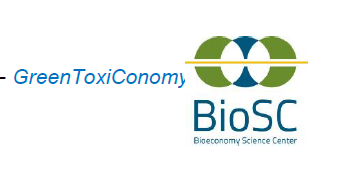NRW – Strategy project BioSC
Funding: SEED FUND 2.0, BioSc — Bioeconmy Science Centre

The NRW strategic project BioSC is supported by:

Project Coordinators:
- Dr. Martina Ross-Nickoll, Institute for Environmental Research, RWTH Aachen University
- Prof. Dr. Henner Hollert, Evolutionary Ecology and Environmental Toxicology, Goethe University Frankfurt
Co-coordination and Research fellow at the Goethe University, Department Evolutionary Ecology & Environmental Toxicology (E
- Dr. Sarah Johann
Co-coordination and Research fellows at the RWTH Aachen:
- Dr. Sebastian Heger
- Dr. Thomas-Benjamin Seiler
- Christoph Kämpfer
Project Partner:
- Prof. Dr. Lars Blank & Dr. Till Tiso, Institute for Applied Microbiology, RWTH Aachen University
- Prof. Dr. Michael Feldbrügge, Silke Jankowski & Dr. Kerstin Schipper, Institute for Microbiology, Heinrich-Heine University Düsseldorf
- Prof. Dr. Andrij Pich, Alexander Töpel & Tim Sassmann, Institute of Technical and Macromolecular Chemistry, RWTH Aachen University and DWI - Leibniz Institute for Interactive Materials e.V.
- Dr. Felix Jacob, BioSc FocusLab greenRelease
- Dr. Nina Ihling, BioSc FocusLab Bio2
- Dr. Anita Loeschcke, BioSc FocusLab CombiCom
BioSC webpage: https://www.biosc.de/eng
The project GreenToxiConomy addresses the implementation of a GreenToxicology strategy in developmental processes of novel, and sustainable compounds that are elaborated within the context of the BioEconomy Science Center (BioSC). A GreenToxicology concept aims to evaluate the safety and environmental impacts of new products already during early steps of product development and optimization, thus enabling to focus on less toxic products without delay or financial loss.
The focus of bioeconomy is to replace compounds of modern life with environmentally friendly counterparts that are based on renewable resources. Within this it is of high importance to investigate the ecotoxicological potential for such “green" chemicals, as environmental impacts cannot be excluded in principle. This project aims to develop a substance-specific and exposure-based proof-of-concept strategy for the two product categories biosurfactants (rhamnolipdies, mannosylerythritol lipids, ustilagic acids) and microgel containers as well as anchoring peptides for the latter. Biosurfactants have a broad range of potential applications including in detergents, remediation or pharmacy. Microgel containers are planned as novel pesticide release systems for plant protection significantly reducing the application amount. Against this background, both substance classes have a high potential to end up in the aquatic and terrestrial environment.
The planned project approach includes as first step to develop and establish ecotoxicological test batteries for the individual product categories considering physical-chemical properties as well as the fields of application. For this literature data and in silico prediction tools will be applied to obtain initial information on toxic potencies of the substances and prioritize biological endpoints of further testing. Afterwards bioassays will be adapted to the specific compounds requirements before the biosurfactants and microgels will be finally investigated to evaluate their ecotoxicological potential.
Related links and literature:
- https://www.biosc.de/December_2018?type=2&id=1235
- Crawford, S.E., Hartung, T., Hollert, H., Mathes, B., van Ravenzwaay, B., Steger-Hartmann, T., Studer, C. and Krug, H.F. (2017) Green Toxicology: a strategy for sustainable chemical and material development. Environmental Sciences Europe 29. Open Access unter: https://enveurope.springeropen.com/articles/10.1186/s12302-017-0115-z
- Johann, S., Seiler, T.B., Tiso, T., Bluhm, K., Blank, L.M. and Hollert, H. (2016) Mechanism-specific and whole-organism ecotoxicity of mono-rhamnolipids. Sci Total Environ 548-549, 155-163.
- Kampfer, C., Seiler, T.B., Beger, A.L., Jacobs, G., Lower, M., Moser, F., Reimer, J., Trautz, M., Usadel, B., Wormit, A. and Hollert, H. (2017) Life cycle assessment and sustainable engineering in the context of near net shape grown components: striving towards a sustainable way of future production. Environmental Sciences Europe 29. Open access unter: https://enveurope.springeropen.com/articles/10.1186/s12302-017-0125-x
- Chen, Q., Gundlach, M., Yang, S., Jiang, J., Velki, M., Yin, D. and Hollert, H. (2017) Quantitative investigation of the mechanisms of microplastics and nanoplastics toward zebrafish larvae locomotor activity. Sci Total Environ 584-585, 1022-1031.
- Bluhm, K., Seiler, T.B., Anders, N., Klankermayer, J., Schaeffer, A. and Hollert, H. (2016) Acute embryo toxicity and teratogenicity of three potential biofuels also used as flavor or solvent. Sci Total Environ 566-567, 786-795.
- Aktuelles und Presse
- Pressemitteilungen
- Öffentliche Veranstaltungen
- Uni-Publikationen
- Aktuelles Jahrbuch
- UniReport
- Forschung Frankfurt
- Aktuelle Stellenangebote
- Frankfurter Kinder-Uni
- Internationales
- Outgoings
- Erasmus / LLP
- Goethe Welcome Centre (GWC)
- Refugees / Geflüchtete
- Erasmus +
- Sprachenzentrum oder Fremdsprachen
- Goethe Research Academy for Early Career Researchers
- Forschung
- Research Support
- Forschungsprojekte, Kooperationen, Infrastruktur
- Profilbereich Molecular & Translational Medicine
- Profilbereich Structure & Dynamics of Life
- Profilbereich Space, Time & Matter
- Profilbereich Sustainability & Biodiversity
- Profilbereich Orders & Transformations
- Profilbereich Universality & Diversity




